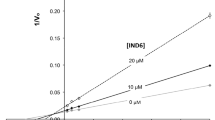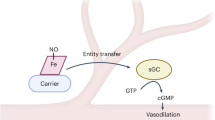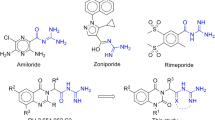Abstract
Three nitric oxide synthase (NOS) isoforms, eNOS, nNOS and iNOS, generate nitric oxide (NO) crucial to the cardiovascular, nervous and host defense systems, respectively. Development of isoform-selective NOS inhibitors is of considerable therapeutic importance. Crystal structures of nNOS-selective dipeptide inhibitors in complex with both nNOS and eNOS were solved and the inhibitors were found to adopt a curled conformation in nNOS but an extended conformation in eNOS. We hypothesized that a single-residue difference in the active site, Asp597 (nNOS) versus Asn368 (eNOS), is responsible for the favored binding in nNOS. In the D597N nNOS mutant crystal structure, a bound inhibitor switches to the extended conformation and its inhibition of nNOS decreases >200-fold. Therefore, a single-residue difference is responsible for more than two orders of magnitude selectivity in inhibition of nNOS over eNOS by L-Nω-nitroarginine-containing dipeptide inhibitors.
This is a preview of subscription content, access via your institution
Access options
Subscribe to this journal
Receive 12 print issues and online access
$189.00 per year
only $15.75 per issue
Buy this article
- Purchase on Springer Link
- Instant access to full article PDF
Prices may be subject to local taxes which are calculated during checkout




Similar content being viewed by others
References
Moncada, S., Palmer, R.M.J. & Higgs, E.A. Nitric oxide: physiology, pathophysiology, and pharmacology. Pharmacol. Rev. 43, 109–142 (1991).
Dinerman, J.L., Lowenstein, C.J. & Snyder, S.H. Molecular mechanisms of nitric oxide prodiction. Potential relevance to cardiovascular disease. Circ. Res. 73, 217–222 (1993).
Kerwin, J.F. Jr., Lancaster, J.R. Jr. & Feldman, P.L. Nitric oxide: A new paradigm for second messengers. J. Med. Chem. 38, 4343–4362 (1995).
Salerno, J.C. et al. An autoinhibitory control element defines calcium-regulated isoforms of nitric oxide synthase. J. Biol. Chem. 272, 29769–29777 (1997).
Nichida, C.R. & Ortiz de Montellano, P.R. Control of electron transfer in nitric-oxide synthases. J. Biol. Chem. 276, 20116–20124 (2001).
Daff, S., Sagami, I. & Shimizu, T. The 42-amino acid insert in the FMN domain of neuronal nitric-oxide synthase exerts control over Ca2+/calmodulin-dependent electron transfer. J. Biol. Chem. 274, 30589–30595 (1999).
Panda, K., Ghosh, S. & Stuehr, D.J. Calmodulin activates intersubunit electron transfer in the neuronal nitric-oxide synthase dimer. J. Biol. Chem. 276, 23349–23356 (2001).
Siddhanta, U. et al. Domain swapping in inducible nitric-oxide synthase. Electron transfer occurs between flavin and heme groups located on adjacent subunits in the dimer. J. Biol. Chem. 273, 18950–18958 (1998).
Dawson, V.L. & Dawson, T.M. Nitric oxide in neurodegeneration. Prog. Brain Res. 118, 215–229 (1998).
Bingham, C.O. III. The pathogenesis of rheumatoid arthritis: pivotal cytokines involved in bone degradation and inflammation. J. Rheumatol. Suppl. 65, 3–9 (2002).
Cho, C.H. Current roles of nitric oxide in gastrointestinal diorders. J. Physiol. Paris 95, 253–256 (2001).
Hobbs, A.J., Higgs, A. & Moncada, S. Inhibition of nitric oxide synthase as a potential therapeutic target. Annu. Rev. Pharmacol. Toxicol. 39, 191–220 (1999).
Taddei, S., Virdis, A., Ghiadoni, L., Sudano, I. & Salvetti, A. Endothelial dysfunction in hypertension. J. Cardiovasc. Pharmacol. 38 (suppl. 2), S11–S14 (2001).
Sachais, B.S. Platelet-endothelial interactions in atherosclerosis. Curr. Atheroscler. Rep. 3, 412–416 (2001).
Rekka, E.A. & Chrysselis, N.C. Nitric oxide in atherosclerosis. Mini Rev. Med. Chem. 2, 433–445 (2002).
Crane, B.R. et al. Structure of nitric oxide synthase oxygenase dimer with pterin and substrate. Science 279, 2121–2126 (1998).
Raman, C.S. et al. Crystal structure of constitutive endothelial nitric oxide synthase: a paradigm for pterin function involving a novel metal center. Cell 95, 939–950 (1998).
Fischmann, T.O. et al. Structural characterization of nitric oxide synthase isoforms reveals striking active-site conservation. Nature Struct. Biol. 6, 233–242 (1999).
Li, H. et al. The novel binding mode of N-alkyl-N′-hydroxguanidine to neuronal nitric oxide synthase provides mechanistic insights into NO biosynthesis. Biochemistry 41, 13868–13875 (2002).
Southan, G.J. & Szabo, C. Selective pharmacological inhibition of distinct nitric oxide synthase isoforms. Biochem. Pharmacol. 51, 383–394 (1996).
Babu, B.R. & Griffith, O.W. Design of isoform-selective inhibitors of nitric oxide synthase. Curr. Opin. Chem. Biol. 2, 491–500 (1998).
Alberton, W.K., Cooper, C.E. & Knowles, R.G. Nitric oxide synthase: structure, function and inhibition. Biochem. J. 357, 593–615 (2001).
Huang, H., Martasek, P., Roman, L.J., Masters, B.S. & Silverman, R.B. N(ω)-nitroarginine-containing dipeptide amides. Potent and highly selective inhibitors of neuronal nitric oxide synthase. J. Med. Chem. 42, 3147–3153 (1999).
Hah, J.-M., Roman, L.J., Martasek, P. & Silverman, R.B. Reduced amide bond peptidomimetica. (4S)-N-(4-amino-5-[aminoalkyl]aminopentyl)-N′-nitroguanidines, potent and highly selective inhibitors of neuronal nitric oxide synthase. J. Med. Chem. 44, 2667–2670 (2001).
Hah, J.-M., Martasek, P., Roman, L.J. & Silverman, R.B. Aromatic reduced amide bond peptidomimetics as selective inhibitors of neuronal nitric oxide synthase. J. Med. Chem. 44, 2667–2675 (2003).
Raman, C.S. et al. Crystal structure of nitric oxide synthase bound to nitro indazole reveals a novel inactivation mechanism. Biochemistry 40, 13448–13455 (2001).
Reif, D.W. & McCreedy, S.A. N-nitro-L-arginine and N-monomethyl-L-arginine exhibit a different pattern of inactivation toward the three nitric oxide synthases. Arch. Biochem. Biophys. 320, 170–176 (1995).
Babu, B.R., Frey, C. & Griffith, O.W. L-arginine binding to nitric-oxide synthase. The role of H-bonds to the nonreactive guanidinium nitrogens. J. Biol. Chem. 274, 25218–25226 (1999).
Li, H. et al. Mapping the active site polarity in structures of endothelial nitric oxide synthase heme domain complexed with isothioureas. J. Inorg. Biochem. 81, 133–139 (2000).
Li, H., Raman, C.S., Martasek, P., Masters, B.S.S. & Poulos, T.L. Crystallographic studies on endothelial nitric oxide synthase complexed with nitric oxide and mechanism-based inhibitors. Biochemistry 40, 5399–5406 (2001).
Ho, S.N., Hunt, H.D., Horton, R.M., Pullen, J.K. & Pease, L.R. Site-directed muta-genesis by overlap extension using the polymerase chain reaction. Gene 77, 51–59 (1989).
Gerber, N.C. & Ortiz de Montellano, P.R. Neuronal nitric oxide synthase, expression in Escherichia coli, irreversible inhibition by phenyldiazene, and active site topology. J. Biol. Chem. 270, 17791–17796 (1995).
Rodriguez-Crespo, I., Gerber, N.C. & Ortiz de Montellano, P.R. Endothelial nitric-oxide synthase expression in Escherichia coli, spectroscopic characterization, and role of tetrahydrobiopterin in dimer formation. J. Biol. Chem. 271, 11462–11467 (1996).
Otwinowski, Z. & Minor, W. Processing of X-ray diffraction data collected in oscillation mode. Methods Enzymol. 276, 307–326 (1997).
Brunger, A.T. et al. Crystallography & NMR System: a new software suite for macromolecular structure determination. Acta Crystallogr. D 54, 905–921 (1998).
Jones, T.A., Zou, J.-Y., Cowan, S.W. & Kjeldgaard, M. Improved methods for building models in electron density and the location of errors in these models. Acta Crystallogr. A 47, 110–119 (1991).
Acknowledgements
We thank the beamline staff at SSRL and ALS for their assistance during synchrotron data collection. This research was supported by US National Institutes of Health grants GM57353 (T.L.P) and GM49725 (R.B.S.). J.A.G. acknowledges NATO and the Spanish Ministry of Science and Technology for support.
Author information
Authors and Affiliations
Corresponding author
Ethics declarations
Competing interests
The authors declare no competing financial interests.
Supplementary information
Rights and permissions
About this article
Cite this article
Flinspach, M., Li, H., Jamal, J. et al. Structural basis for dipeptide amide isoform-selective inhibition of neuronal nitric oxide synthase. Nat Struct Mol Biol 11, 54–59 (2004). https://doi.org/10.1038/nsmb704
Received:
Accepted:
Published:
Issue Date:
DOI: https://doi.org/10.1038/nsmb704
This article is cited by
-
Anchored plasticity opens doors for selective inhibitor design in nitric oxide synthase
Nature Chemical Biology (2008)
-
Structural studies of constitutive nitric oxide synthases with diatomic ligands bound
JBIC Journal of Biological Inorganic Chemistry (2006)



